Sometimes rough skin on the feet spoils both your appearance and your mood; even the most sophisticated shoes in this case cannot save the situation. Why do heels get rough and how to fix the problem? Let's figure it out.

Why do my heels get rough?
Thickening of the skin on the feet is a kind of protective reaction to negative conditions. There are many reasons for rough skin on the feet:
low-quality shoes with uncomfortable lasts or high heels. If the body weight is not distributed correctly, the pressure may be too strong on some areas of the foot, and when wearing such a pair for a long time, the skin on them becomes rough;
improper or insufficient care of the skin of the feet. If you do not use a nourishing cream after hygiene procedures or, on the contrary, are too carried away with pedicure blades, cutting off rough skin, this will inevitably lead to its thickening;
Why do heels get rough quickly in summer? Wearing flip-flops and walking barefoot is a direct way to thicken the skin on your feet;
overweight. Extra pounds significantly increase the load on the feet, leading to thickening of the skin;
disturbance of blood sugar levels. If cracks appear on the heels, and with them other symptoms - drowsiness, increased appetite, weakness and numbness of the limbs - you should consult a doctor as soon as possible and get tested;
vitamin deficiency. If, in addition to stiff feet, you are concerned about dry skin, brittle hair and nails, you should review your diet or purchase a high-quality vitamin complex.
If the roughness of the heels is caused by a disease, before putting them in order, it is worth eliminating the cause. If the problem is in your shoes, you should change them, otherwise the situation will worsen. If it’s all about improper care or heavy load on the feet, you can try to cope on your own.
What to do if your heels get rough
This problem can be solved. You can go to the salon and undergo a course of European pedicure, paraffin therapy and other professional procedures. With due persistence, the result will not be long in coming. You can get by with improvised means:
Before going to bed, steam your feet in warm water. Dry with a towel and make a compress with apple cider vinegar. Secure it with film, put on warm socks and go to bed. In the morning, remove the compress and gently exfoliate dead cells with a brush or pumice stone. Do not use metal scrapers or blades! Then you need to rinse your feet and apply a nourishing cream. Repeat the procedure until the feet become smooth, then do it as a preventive measure once every two to three weeks;
Brew a full handful of onion peels with 2 liters of water. Leave for about an hour. Then you need to prepare a hot foot bath from the infusion: add a tablespoon of baking soda and table salt to it, soak your feet and keep until completely cool. Then pat the skin dry and apply raw yolk first, then any nourishing oil. Wrap up and leave overnight. Repeat every other day until the desired result is obtained;
Cedar resin helps with cracks on rough heels. The healing agent should be applied daily to problem areas at night, in the morning the skin should be rinsed and a nourishing cream should be applied. The procedure may darken the epidermis for some time, but after three or four procedures, the cracks will disappear, and the skin color will very soon become familiar.
Now you know why your heels become rough and how to deal with it. With regular proper care, your heels will become smooth and soft again. If, despite all efforts, this does not happen, consult a dermatologist; this problem may only be a symptom of the disease and will disappear after its treatment.
It is very important for any girl to feel attractive and well-groomed. To achieve this, you need to take care of your appearance, devoting a lot of time to cosmetic procedures. Unfortunately, not all girls adhere to this rule when it comes to hygienic pedicure. Very often, we remember that the skin on our feet also needs regular care only in the warm season, when we want to show off in open shoes. However, if you do not pay attention to the condition of your feet and toes for a long time, and do not do a hygienic pedicure, then their appearance may become the cause of your disappointment. The appearance of rough skin on the heels will negate all your efforts to be beautiful, since with such a significant flaw your legs will look unkempt.

Causes of rough and rough skin on the legs
The skin of the feet needs regular care, because without this, the heels become rough and become covered with a kind of crust consisting of keratinized cells. What should you do in such a situation? First of all, you need to find out why this happened, and only then do something. Let's look at the main causes of rough skin on the feet.
- Rough heels are most often found in those who, due to their duty, have to spend a lot of time on their feet. Most hairdressers, salespeople, and waiters are familiar with this problem firsthand.
- Tight and uncomfortable shoes, as well as sandals and high-heeled shoes, adversely affect the condition of your feet. Due to constant discomfort and stress, the skin on the heels gradually becomes rougher, hard and rough.
- Overweight girls suffer from this problem more often than others. Extra pounds put double the stress on your feet, making your heels unattractive due to layers of rough skin accumulating on their surface.
- Horny skin on the feet is a common occurrence among those who like to walk barefoot on sand or grass in the warm season. Sometimes you can pamper your feet in this way, but you should not forget that after this your heels need more careful care.
- Some fungal diseases cause problems such as a rough and rough surface of the foot. In this case, the keratinized cells very quickly layer on top of each other, forming a hard and dry crust. Although some folk remedies are quite effective in treating fungus, it is recommended that you first consult a dermatologist to properly eliminate the disease.
- Rough heels can occur as a result of various health problems or severe vitamin deficiencies. Disorders of the endocrine system, disruptions in the body, kidney disease, etc., affect the condition of the feet and nails, the skin on the heels and toes.
The same reasons can affect the appearance of pain, cracks, corns and calluses, and general discomfort when walking. Dont be upset! Regular cosmetic procedures, all kinds of folk remedies and an integrated approach will help you cope with this problem. Having figured out why unsightly, rough and rough heels appear, you can choose the right method to eliminate such a defect.
Methods for dealing with rough skin on the heels
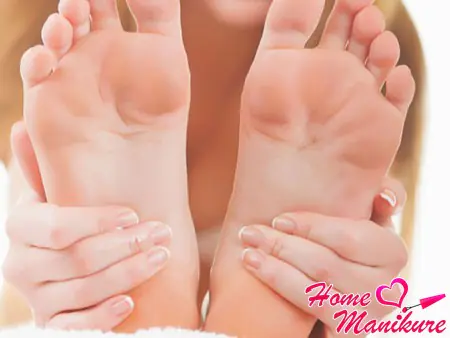
When it comes to any diseases or malfunctions of the body, as well as fungal infections, you should not treat yourself. Before you do anything, consult a doctor who can determine why your heels are developing a crust of hard skin and properly solve the problem. So, if you are sure that the reasons for the appearance of such an unsightly defect in the legs as rough patches of skin on the heels are purely cosmetic in nature, then let's try to save our legs.
Get ready for the fact that you will have to spend a certain amount of time to restore the beauty of your feet and toes. Only regular procedures, daily care and following important recommendations will help you regain soft and smooth skin on your heels.. Folk remedies that can very effectively and carefully solve many problems related to beauty and health can help you with this.
Steaming foot baths
In order for the rough, thick and rough skin of the feet to thoroughly soften, it is necessary to take warm baths for several days in a row. After steaming and treating your feet, be sure to apply nourishing cream or oil with vitamin E to your feet and put on socks. These procedures will help you not only get your feet in order, but will also significantly improve the condition of the skin on your feet, and will also affect the strengthening and rapid growth of nail plates.
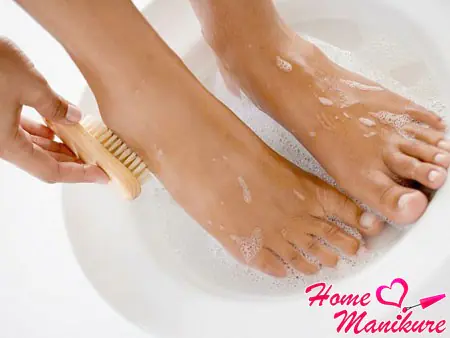
- Soda solution. A bath of soda will cope with this task very well; preparing it will not be difficult. You need to add ordinary baking soda to warm water. For a liter of water you will need one tablespoon of baking soda. Soak your feet in this solution for about 15 minutes, then use a pumice stone, brush or pedicure file to remove dead skin. After you have treated rough areas of the skin, sand the surface of the heels and lubricate your feet with cream.
- Bath based on sea salt. Preparing a saline solution is based on the same principle as a baking soda bath. You can add a few drops of any essential oil to the liquid to your taste. This will allow you to relax under the influence of your favorite aroma and make the procedure even more enjoyable.
- Medicinal herbal decoctions. Brew chamomile flowers, calendula or St. John's wort, which are sold in any pharmacy. Cool the solution and keep your nails in the warm broth for about half an hour. These folk remedies will intensively soften the stratum corneum of the skin, while providing a calming and disinfecting effect. In addition, medicinal herbs can be used for preventive purposes against possible fungal infections.
- Lemon juice bath. Squeeze the juice of several lemons into a small container and soak your feet in it for 10-15 minutes. The acid contained in this citrus will dissolve rough areas of the epidermis. Rinse your feet with water, and then painlessly and gently use a pumice stone or rough washcloth to begin scrubbing away dead and dry tissue cells from your heels.
Natural oils
Rough skin on the feet causes cracks in the heels, which can be treated with vegetable oils, which have excellent softening and healing properties. Olive, almond, sea buckthorn and peach oils are perfect for these purposes. Before direct application, the oily composition must be slightly warmed up, and when distributing the mixture over the feet, it is better to accompany this process with a light massage.
After the procedure, wrap your feet in plastic and put on socks. It is best to do this before bed so that the skin on your heels can properly absorb the oils. Repeat the procedure until you see the desired result. After steaming and treating your feet with a pumice stone or brush, you can lubricate your feet with oils to achieve a better result.
Roller file Scholl Velvet Smooth

Another excellent product for removing dead skin on the legs is a special battery-operated Scholl Velvet Smooth roller file. A distinctive feature of this method of foot treatment is that in order to get rid of hardened epidermis accurately and painlessly, there is no need to steam your feet in a bath. With a Scholl electric file, you need to work dry, methodically and measuredly processing every millimeter of skin, without fear of harming your health.
However, you should not expect colossal results from this miracle device if your legs are in disrepair. In this case, you should contact a specialist who will give you a high-quality and effective hardware pedicure. But don't think that even after a thorough foot treatment by a professional, you can relax without taking the time to take care of your feet. Do not forget that without proper and timely care, keratinized skin will appear on your heels again, which will cause a bad mood and unsightly condition of your feet..
In other cases, the Scholl roller file will delight you with its efficiency and delicacy, helping to keep your legs in perfect condition. Watch a short video about how this electrical device works to visually evaluate its capabilities. If you are interested in this miracle file, you can find the best offers in the online store PilkaScholls.com - there you will also find cool gifts in Scholl sets. Remember, flawless feet require daily care! Take care of yourself, appreciate your beauty and be irresistible!
Main causes and descriptions of common diseases
The causes of rough skin on the legs are varied. This can be either a consequence of external factors (poor hygiene, lack of proper care, excessive stress on the feet, etc.), or the result of internal pathologies. The most commonly diagnosed are fungal diseases and allergic contact dermatitis. Men aged 25-45 years are more affected. All possible causes of dry dermis on the feet are discussed below.
| Cause | Peculiarities |
| Shoes | Constantly wearing uncomfortable shoes (high heels, tight shoes, made from unnatural materials) is one of the most common reasons for the appearance of rough skin on the feet. |
Metabolic processes in tissues are disrupted, nutrients in the required quantities cease to flow into cells, and the dermis dries out and becomes rough.
Lack of care The skin of the feet, like any other part of the body, needs daily care, which includes not only hygiene, but also cleansing with scrubs, baths with medicinal plants, and nourishment with creams. In the absence of care, rough skin on the feet, cracks and corns appears, which means there is a risk of contracting fungus and other infectious diseases. Dry skin This condition of the dermis is inherited. With appropriate care, roughening of the skin can be avoided. But, in the absence of nutrition, the skin begins to dry out. The process is aggravated by wearing inappropriate shoes. Walking without shoes Walking barefoot in itself is beneficial, but when doing it on a hard and uneven surface, you must definitely take care of the skin of your feet after training. Psoriasis One of the skin diseases that is characterized by:· papular rash;
· dry skin with the formation of cracks;
· the appearance of bright red areas at the site of the lesion;
· feeling of neuralgia when walking;
· disorders in the tissues of the nails, etc.
Fungus Mycosis of the foot is one of the most common skin diseases. The causes of the disease are:· long stay in water;
· constant wearing of tight and closed shoes;
· high temperatures in the patient's location.
Athlete's foot One type of fungal infection is characterized by:· itching and burning;
· the appearance of ulcers, vesicles, cracks and blisters.
Allergy In appearance, the atopic reaction on the feet resembles a fungus, but in addition to dry skin with blistering formations, the following can be observed:· rash on the palms;
· temperature, etc.
Diabetes mellitus Poor circulation and nerve damage leads to poor wound healing and loss of sensation. Any cracks in the skin of the feet turn into ulcers. The patient may not even immediately notice the pathological process (blunting of nerve endings). The disease is often accompanied by infection, which can lead to amputation of limbs. Obesity With impaired metabolism, rough skin on the feet is a common occurrence. Deficiency of vitamins and minerals (fasting or dieting) The nutrition of skin cells is insufficient, so it dries out and cracks appear. If there is no additional care (or, conversely, traumatic exfoliation of the keratinized layer of the dermis occurs), then the area of the coarsened dermis thickens even more. Worms Coarsened skin on the feet is a consequence of a lack of vitamins A, E and B in the body due to the presence of helminths. Other signs of the disease:· disruption of the gastrointestinal tract;
weakness and chronic fatigue;
· joint pain;
· manifestations of skin allergies in people prone to atopic reactions.
Disruption of the gastrointestinal tract. Any such pathology affects the appearance of a person. The condition of hair, skin and nails worsens. Dry dermis on the legs is a lack of nutrients in the patient’s body due to illness.Rough skin on feet photo
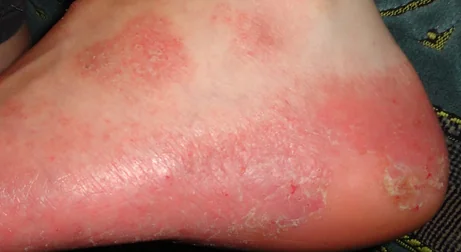
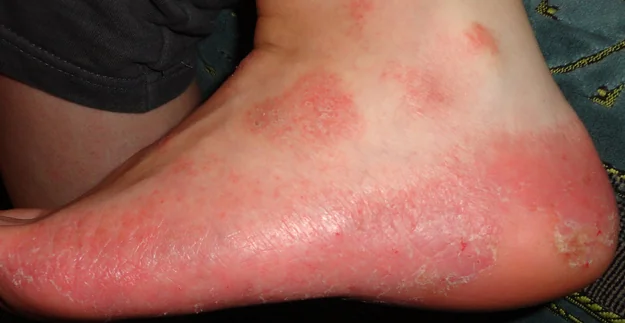
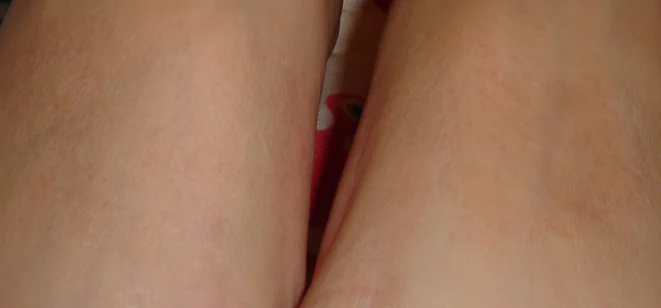
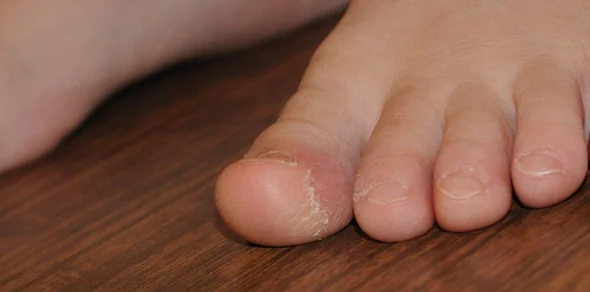
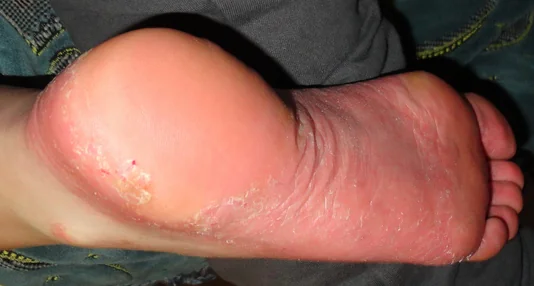
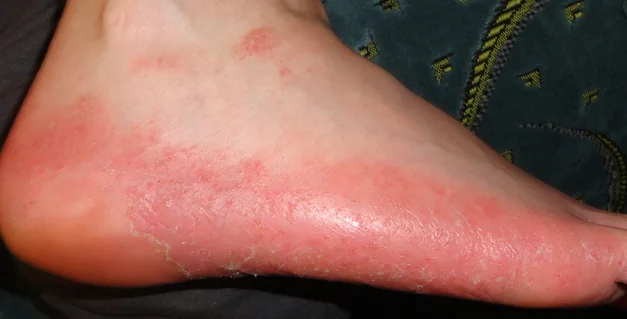
Preventive actions
Preventative measures to maintain healthy skin on your feet:
- wearing comfortable shoes (alternate shoes with and without heels, avoid uneven insoles and shoes made of materials that do not allow air to pass through);
- using nourishing foot cream every evening before bed, enhancing the effectiveness of the product with cotton socks;
- boosting immunity with vitamin complexes;
- treating the dermis with scrubs 2 times a week;
- do not use a razor to trim dead skin;
- Don't wear someone else's shoes.
Treatment of rough skin on the legs is indicated only for fungal infections and psoriasis. For this purpose, antifungal and antihistamine drugs are used, which are selected by the attending physician based on the clinical picture and the causative agent. The allergic reaction goes away after eliminating the irritants. Bepanten and Panthenol are indicated to relieve symptoms.



